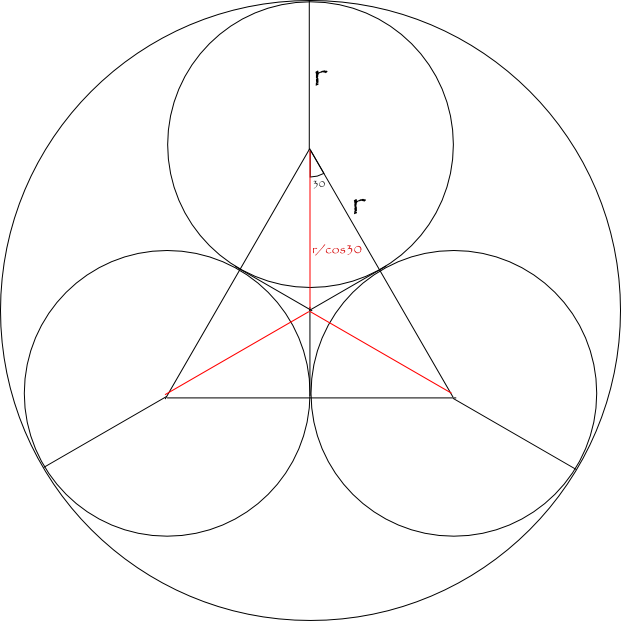Four marbles of radius #3/8# inch are placed in a cylindrical container. The first three marbles fit snuggly with the fourth marble on top. The cylinder is then filled with water up to the top of the fourth marble. What is the volume of water?
2 Answers
Explanation:
Each marble will have a volume of
and the 4 marbles will have at total volume of
The cylinder containing them (up to the height of the fourth marble has a volume of:
The Volume of the water (i.e. the volume of the cylinder not occupied by the marbles) is
Explanation:
Denote the radius of a marble by

Then the radius of the cylinder is:
#r + r / cos(30^@) = r + r / (sqrt(3)/2) = r + ((2r)/sqrt(3)) = r+(2sqrt(3)r)/3 = r((3+2sqrt(3))/3) = (3+2sqrt(3))/8 "inches"#
Next, the total height of the stack of marbles will be
From some slightly messy calculations, the height of a tetrahedron with edges of length
Viewed from one side, the tetrahedron looks like a triangle with base of length
Then:
#sqrt(3)r = sqrt((sqrt(3)r)^2 - h^2) + sqrt((2r)^2 - h^2)#
#= sqrt(3r^2-h^2) + sqrt(4r^2-h^2)#
Square both sides to get:
#3r^2 = 3r^2-h^2+4r^2-h^2 + 2sqrt((3r^2-h^2)(4r^2-h^2))#
Hence:
#sqrt((3r^2-h^2)(4r^2-h^2)) = h^2-2r^2#
Square both sides again to get:
#(3r^2-h^2)(4r^2-h^2) = (h^2-2r^2)^2#
That is:
#12r^4-7r^2h^2+h^4 = h^4-4h^2r^2+4r^2#
So:
#8r^4 = 3h^2r^2#
Divide both sides by
#h = sqrt(8)/sqrt(3)r = (2sqrt(6))/3r#
So the total height of the stack of marbles is:
#2r + (2sqrt(6))/3r = (6+2sqrt(6))/3r = (6+2sqrt(6))/8 "inches" = (3+sqrt(6))/4 "inches"#
The volume of the cylinder up to this height is:
#"{area of circle}" xx "{height}"#
#=pi ((3+2sqrt(3))/8)^2 xx (3+sqrt(6))/4 "inches"^3#
#=pi ((21+12sqrt(3))/64) xx (3+sqrt(6))/4 "inches"^3#
#=pi (63+36sqrt(3)+21sqrt(6)+36sqrt(2))/256 "inches"^3#
The volume of each marble is:
#4/3 pi r^3 = 4/3 pi (3/8)^3 "inches"^3#
#= pi 9/128 "inches"^3#
So the volume of four marbles is:
#= pi 9/32 "inches"^3#
So the total volume of water will be:
#pi (63+36sqrt(3)+21sqrt(6)+36sqrt(2))/256 "inches"^3 - pi 9/32 "inches"^3# =
#pi (63+36sqrt(3)+21sqrt(6)+36sqrt(2))/256 "inches"^3 - pi 72/256 "inches"^3# =
#pi (36sqrt(3)+21sqrt(6)+36sqrt(2)-9)/256 "inches"^3#

